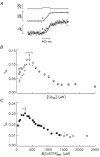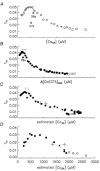Recruitment of Ca(2+) release channels by calcium-induced Ca(2+) release does not appear to occur in isolated Ca(2+) release sites in frog skeletal muscle
- PMID: 12411523
- PMCID: PMC2290617
- DOI: 10.1113/jphysiol.2002.026658
Recruitment of Ca(2+) release channels by calcium-induced Ca(2+) release does not appear to occur in isolated Ca(2+) release sites in frog skeletal muscle
Abstract
Ca(2+) release from the sarcoplasmic reticulum (SR) in skeletal muscle in response to small depolarisations (e.g. to -60 mV) should be the sum of release from many isolated Ca(2+) release sites. Each site has one SR Ca(2+) release channel activated by its associated T-tubular voltage sensor. The aim of this study was to evaluate whether it also includes neighbouring Ca(2+) release channels activated by Ca-induced Ca(2+) release (CICR). Ca(2+) release in frog cut muscle fibres was estimated with the EGTA/phenol red method. The fraction of SR Ca content ([Ca(SR)]) released by a 400 ms pulse to -60 mV (denoted f(Ca)) provided a measure of the average Ca(2+) permeability of the SR associated with the pulse. In control experiments, f(Ca) was approximately constant when [Ca(SR)] was 1500-3000 microM (plateau region) and then increased as [Ca(SR)] decreased, reaching a peak when [Ca(SR)] was 300-500 microM that was 4.8 times larger on average than the plateau value. With 8 mM of the fast Ca(2+) buffer BAPTA in the internal solution, f(Ca) was 5.0-5.3 times larger on average than the plateau value obtained before adding BAPTA when [Ca(SR)] was 300-500 microM. In support of earlier results, 8 mM BAPTA did not affect Ca(2+) release in the plateau region. At intermediate values of [Ca(SR)], BAPTA resulted in a small, if any, increase in f(Ca), presumably by decreasing Ca inactivation of Ca(2+) release. Since BAPTA never decreased f(Ca), the results indicate that neighbouring channels are not activated by CICR with small depolarisations when [Ca(SR)] is 300-3000 microM.
Figures



Similar articles
-
A study of the mechanisms of excitation-contraction coupling in frog skeletal muscle based on measurements of [Ca2+] transients inside the sarcoplasmic reticulum.J Muscle Res Cell Motil. 2018 Apr;39(1-2):41-60. doi: 10.1007/s10974-018-9497-9. Epub 2018 Aug 24. J Muscle Res Cell Motil. 2018. PMID: 30143958 Review.
-
Extra activation component of calcium release in frog muscle fibres.J Physiol. 2002 Aug 1;542(Pt 3):867-86. doi: 10.1113/jphysiol.2002.017095. J Physiol. 2002. PMID: 12154185 Free PMC article.
-
Effect of sarcoplasmic reticulum (SR) calcium content on SR calcium release elicited by small voltage-clamp depolarizations in frog cut skeletal muscle fibers equilibrated with 20 mM EGTA.J Gen Physiol. 1998 Aug;112(2):161-79. doi: 10.1085/jgp.112.2.161. J Gen Physiol. 1998. PMID: 9689025 Free PMC article.
-
Calcium release and its voltage dependence in frog cut muscle fibers equilibrated with 20 mM EGTA.J Gen Physiol. 1995 Aug;106(2):259-336. doi: 10.1085/jgp.106.2.259. J Gen Physiol. 1995. PMID: 8537818 Free PMC article.
-
Regulation of the ryanodine receptor calcium release channel of the sarcoplasmic reticulum in skeletal muscle.Acta Physiol Hung. 1999;86(2):77-97. Acta Physiol Hung. 1999. PMID: 10741867 Review.
Cited by
-
Tracking the sarcoplasmic reticulum membrane voltage in muscle with a FRET biosensor.J Gen Physiol. 2018 Aug 6;150(8):1163-1177. doi: 10.1085/jgp.201812035. Epub 2018 Jun 13. J Gen Physiol. 2018. PMID: 29899059 Free PMC article.
-
Role of calsequestrin evaluated from changes in free and total calcium concentrations in the sarcoplasmic reticulum of frog cut skeletal muscle fibres.J Physiol. 2007 May 15;581(Pt 1):319-67. doi: 10.1113/jphysiol.2006.126474. Epub 2007 Mar 1. J Physiol. 2007. PMID: 17331996 Free PMC article.
-
A study of the mechanisms of excitation-contraction coupling in frog skeletal muscle based on measurements of [Ca2+] transients inside the sarcoplasmic reticulum.J Muscle Res Cell Motil. 2018 Apr;39(1-2):41-60. doi: 10.1007/s10974-018-9497-9. Epub 2018 Aug 24. J Muscle Res Cell Motil. 2018. PMID: 30143958 Review.
-
Synthetic localized calcium transients directly probe signalling mechanisms in skeletal muscle.J Physiol. 2012 Mar 15;590(6):1389-411. doi: 10.1113/jphysiol.2011.225854. Epub 2012 Feb 6. J Physiol. 2012. PMID: 22310315 Free PMC article.
-
Calcium buffering properties of sarcoplasmic reticulum and calcium-induced Ca(2+) release during the quasi-steady level of release in twitch fibers from frog skeletal muscle.J Gen Physiol. 2012 Oct;140(4):403-19. doi: 10.1085/jgp.201110730. J Gen Physiol. 2012. PMID: 23008434 Free PMC article.
References
Publication types
MeSH terms
Substances
LinkOut - more resources
Full Text Sources
Research Materials
Miscellaneous

